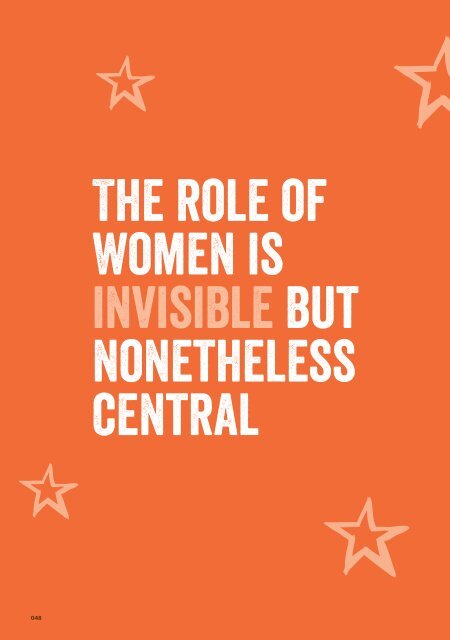EMPOWERMENT
DanoneWomenEmpowerment
DanoneWomenEmpowerment
You also want an ePaper? Increase the reach of your titles
YUMPU automatically turns print PDFs into web optimized ePapers that Google loves.
The role of<br />
Women is<br />
invisible but<br />
nonetheless<br />
central<br />
WOMEN IN THEIR ROLES AS MOTHERS, DAUGHTERS<br />
AND WIVES ARE AT THE CENTER OF ALL SOCIAL FAMILY<br />
ACTIVITIES WHICH ARE VERY CLOSELY LINKED WITH<br />
CULTURE, RELIGION AND TRADITIONS, MAKING IT A<br />
COMPLEX WEB. GENERALIZATIONS ARE NOT ONLY<br />
IMPOSSIBLE BUT DANGEROUS. THERE IS NO PANACEA<br />
SOLUTION, NO MAGIC RECIPE.<br />
“I have now spent almost three years in Danone Ecosystem,<br />
working on various projects in multiple countries and have<br />
spent the last two years trying to understand the very<br />
complex topic of women empowerment. And I must admit<br />
I have just begun to scratch the surface.<br />
Since its creation, the Danone Ecosystem Fund has had<br />
the aspiration of empowering women and, even though it’s<br />
always easier said than done, we have made steady progress.<br />
At Ecosystem, our purpose is to create inclusive business<br />
models within Danone’s Ecosystem. We never design<br />
our projects with a singular purpose of gender equality<br />
or women empowerment. Yet we have discovered that in<br />
all economies, and especially in the informal, small scale<br />
ones, the role of women is invisible but nonetheless central.<br />
And therein lies our biggest opportunity for launching and<br />
sustaining inclusive business models. Including the invisible<br />
yet omnipresent women makes perfect business sense!<br />
Family agriculture, unorganized small scale retail and<br />
niche caring services are all activities where women<br />
invest time and energy in, most often, with little visibility<br />
and compensation or remuneration for the work they<br />
are engaged in. Women are everywhere, working and<br />
contributing, but they need support to realize their full<br />
potential. Yet most projects don’t take women and their<br />
specificities into account. To address this reality, we need<br />
to use a gender lens at all times. This lens allows people in<br />
the field to ask the right questions and thus discover the<br />
‘invisible’ women and the opportunity that can be unlocked.<br />
To give you a simple example, we often use the term<br />
‘farmers’ in our projects with dairy producers. One of our<br />
key learnings is to qualify this term. There are men farmers<br />
and women farmers. Designing any project to enhance<br />
productivity and efficiency will need a set of interventions<br />
that will include both men and women farmers. Using a<br />
gender lens has helped us in pinpointing specific women<br />
challenges and thus designing much more relevant and<br />
therefore effective interventions.<br />
Working on the field with our partners has taught us that<br />
what seems like a simple path of enhancing capabilities,<br />
providing the right support and creating adequate<br />
infrastructure needs a more careful treading. Women in<br />
their roles as mothers, daughters and wives are at the center<br />
of all social family activities which are very closely linked<br />
with culture, religion and traditions, making it a complex<br />
web. Generalizations are not only impossible but dangerous.<br />
What works in one setting will most often not work in<br />
another. There is no panacea solution, no magic recipe. The<br />
most important first step is to take the time to deep dive into<br />
the local context.<br />
To create this book, we interviewed experts, our partners<br />
and the Ecosystem’s team to understand how they address<br />
the topic of women empowerment in their projects. They<br />
were kind enough to take time to share their rich experience<br />
with us. This chapter captures our collective experiences<br />
and learning in five sections, each section structured in<br />
two parts: “Expert’s perspective” and “Project manager’s<br />
experience” to give you a well-rounded perspective. We<br />
have interspersed these chapters with a few of our project<br />
infographics. The objective is to give you a peep into a few<br />
of our projects where we have been able to support women<br />
and impact them in meaningful ways.<br />
I sincerely hope that the next few pages will give you<br />
some interesting and useful insights from our women<br />
empowerment experience.<br />
Sama Taneja<br />
Danone Ecosystem Fund<br />
Regional Manager Asia & Lead Women Empowerment<br />
048<br />
049


